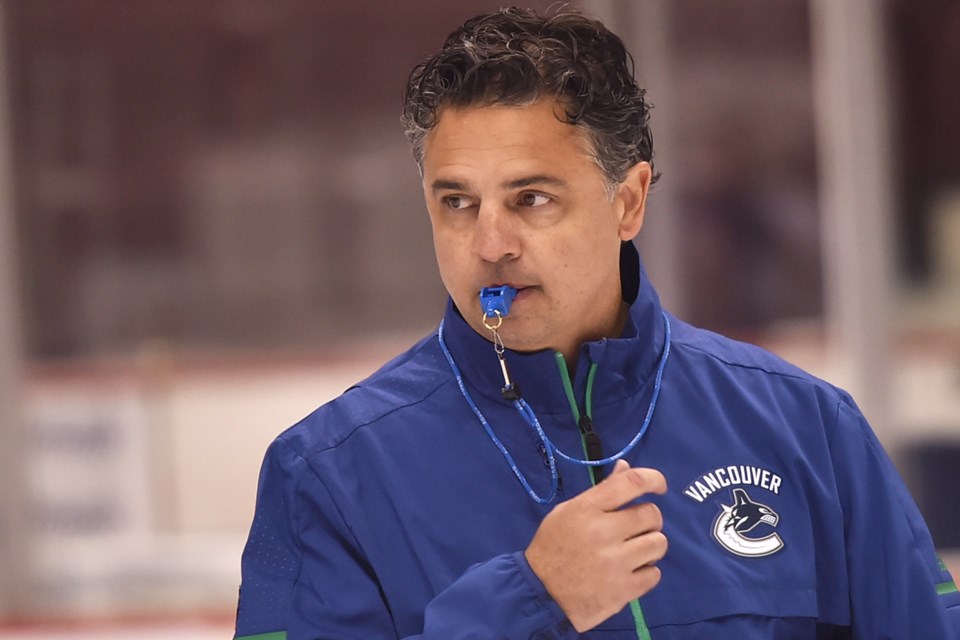The Canucks power play was absolutely stunning on Saturday night against the Calgary Flames. Just not in a good way.
In the first period, the Canucks drew five penalties, giving them 8 minutes and 49 seconds on the power play, including over a minute at 5-on-3. Incredibly, the Canucks were out-shot during those five power plays and gave up the game’s opening goal shorthanded. Their lame duck power play gave the Flames all the momentum heading into the first intermission
Gifted a two-man advantage early in the game, the Canucks didn’t get a single shot on goal. As the first penalty ended, the Flames got a 3-on-1 when Sam Gagner, the forward at the point, got caught flat-footed. Perhaps Jacob Markstrom should have had Mark Giordano’s subsequent shot, but it’s awfully hard to blame the goaltender for the Canucks’ power play struggles.
By the end of the first period, the Canucks had just one shot on goal on the power play. The Flames had two, one of which went in. By the end of the game, shots were 3-3 on the Canucks’ power play.
The Canucks don’t have the worst power play in the league — the Ducks and Islanders have yet to score a single power play goal — but their 2-for-23 power play isn’t far from the bottom. On top of that, they have just 30 shots on their 23 power plays.
This isn’t the way it was supposed to be. The additions of Sam Gagner, Thomas Vanek, Michael Del Zotto, and Brock Boeser, along with the return of Newell Brown behind the bench, were supposed to help fix the Canucks’ ailing power play, but thus far the only thing that has really changed is their willingness to change.
At the end of his tenure as head coach of the Canucks, Willie Desjardins infamously said that he refrained from making changes to his power play units because he didn’t want to disrupt their “chemistry.” Considering the Canucks posted their worst power play percentage in 20 years, it’s safe to say that they had less chemistry than Kelly Clarkson and Justin Guarini.
So it was refreshing to see Brown and Travis Green throw “chemistry” out the window at Monday’s practice as they prepare to face the Ottawa Senators Tuesday night. Sure, the power play units they put together on Monday are somewhat alarming, but there is at least a willingness to admit that what they have been doing through the first four games wasn’t working.
PP units
— Brendan Batchelor (@BatchHockey) October 16, 2017
Sedin-Sedin-Granlund
Del Zotto-Hutton
Baertschi-Burmistrov-Boeser
Pouliot-Stecher
Gagner-Horvat-Vanek 3rd forward unit. #Canucks pic.twitter.com/Aw7FF6AmVT
There are a couple things that stand out: the first is initially moving Gagner, Horvat, and Vanek, three of their best power play options, to a third unit that likely wouldn’t see ice time. That’s not likely to last and, indeed, Gagner later switched in for Granlund on the Sedin unit, giving them a right-handed shot to work with.
What might be more notable is the use of two defencemen in practice on both units. The Canucks have four good power play options on the blue line between Del Zotto, Hutton, Pouliot, and Stecher, and the Canucks have been burned a couple times with a forward back at the point. If these units stay intact on Tuesday, it will be interesting to see how a two-defencemen dynamic will change their approach with the man advantage.
Ultimately, the biggest change that the Canucks will have to make at some point this season is to give the Sedins less time with the man advantage. The twins are still the team leaders in power play ice time, but are not producing enough shots and scoring chances to justify it. Perhaps they turn that around at some point or the right combination of teammates on their unit gives them a boost, but it might be best to start giving the Canucks’ young forwards the bulk of the power play ice time to see if they can sort it out.



